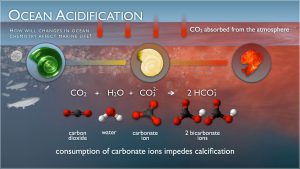
Acid eats away at calcium carbonate, the primary ingredient of shells and skeletons that many ocean animals depend on for survival. The shell pictured here is a victim of this process. The normally-protective shell is so thin and fragile, it is transparent.
Since the start of the industrial revolution, the ocean has silently absorbed roughly 30% of the carbon dioxide that people generate through industry and agriculture. Now ocean chemistry of the seawater is rapidly changing in a process known as ocean acidification. These changes in seawater chemistry affect animal growth, survival and behavior, and they are depleting the ocean of calcium carbonate, a nutrient vital for shellfish to build shells. Marine organisms with calcium carbonate shells or skeletons – such as corals, oysters, clams, and mussels – can be affected by small changes in acidity. That's important, because shelled organisms are essential throughout the marine food chain. They are also vital to our economy, as shellfish hatcheries on the brink of collapse just a few years ago, struggle to adapt.
IOOS is helping mitigate economic impacts with real-time data that signal the approach of acidified seawater one to two days before it arrives. An early warning helps hatchery managers take action - such as shutting off intake valves or treating the water - to save crops.
Too much acid in the ocean is bad news for sea life. The shell pictured here is a victim of this process
Too much acid in the ocean is bad news for sea life. Acid eats away at calcium carbonate, the primary ingredient of shells and skeletons that many ocean animals depend on for survival. The shell pictured here is a victim of this process. The normally-protective shell is so thin and fragile, it is transparent.
NOAA's Ocean Acidification Program
The NOAA Ocean Acidification Program focuses on monitoring the changes in the ocean chemistry, researching potential effects on organisms and ecosystems, and understanding the socio-economic impacts of those changes.
Knowledge from this research will allow to explore adaptations strategies and to better communicate the progress and implications of ocean acidification with scientists, stakeholders, and the public.
IOOS and OAP: A Partnership for OA monitoring
Ocean acidification has the potential to fundamentally change the ocean, its habitats, food webs and marine life. The implications of this sea change to our environment and our economy are endless, and the current rate of change of ocean acidification is faster than any time on record. We need to better understand what is happening so we can develop tools to help slow the rate of change. Efforts of IOOS and OAP will help our nation begin to understand how to address this problem on a global scale and help reverse it.
The following IOOS Regional Associations support national OA monitoring and related activities:
 Official websites use .gov
A .gov website belongs to an official government organization in the United States.
Official websites use .gov
A .gov website belongs to an official government organization in the United States.
 Secure .gov websites use HTTPS
A lock or https:// means you’ve safely connected to the .gov website. Share sensitive information only on official, secure websites.
Secure .gov websites use HTTPS
A lock or https:// means you’ve safely connected to the .gov website. Share sensitive information only on official, secure websites.
